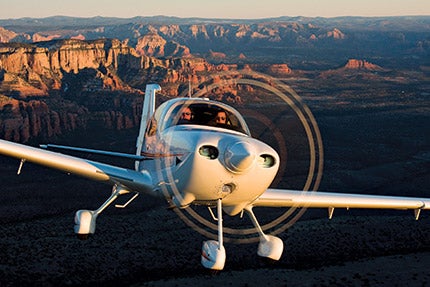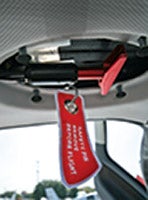 Just over a decade ago, buying a brand-new aircraft wasn’t an option. While you might have been able to special-order something esoteric, most legacy manufacturers had altogether stopped building new airplanes. When you could buy something brand-new, it looked just like the airplanes already sitting on the ramp, albeit a bit shinier and with that “new plane” smell. The technology, both in the cockpit and within the engine, was pretty much the same from one aircraft to another and hadn’t really progressed much in more than 40 years. The designs of the aircraft themselves had stayed pretty much the same since the 1950s.
Just over a decade ago, buying a brand-new aircraft wasn’t an option. While you might have been able to special-order something esoteric, most legacy manufacturers had altogether stopped building new airplanes. When you could buy something brand-new, it looked just like the airplanes already sitting on the ramp, albeit a bit shinier and with that “new plane” smell. The technology, both in the cockpit and within the engine, was pretty much the same from one aircraft to another and hadn’t really progressed much in more than 40 years. The designs of the aircraft themselves had stayed pretty much the same since the 1950s.
The characteristics that motivated new airplane buyers back then were simple: performance, some brand loyalty and personal taste. Performance was the biggest variable and, aside from the looks of the airplane, was the major factor in deciding which airplane to buy.
Then something happened. In 1991, an Austrian motorglider manufacturer, Diamond Aircraft, introduced its new composite airplane, the DV20 “Katana.” At the same time, Liberty Aerospace flew its prototype trainer, created by a former Airbus designer. Not long after that, Cirrus Design introduced the SR20, also built from composites. When the Liberty XL2 was certified in 2004, it became the first two-seat aircraft to receive FAA certification in more than 30 years. A new era of aircraft manufacturing was born.
The result of this surge in new manufacturing is a sweeping change across our airport ramps. The buyer of old has given way to the buyer of new, and the old GA fleet is slowly being replaced. For the first time in three decades, flight schools are offering brand-new, advanced aircraft instead of aging trainers.
We spoke with several manufacturers to identify the psychographic of today’s new aircraft buyer. Each cited technology as a prime reason to buy. “The point of reference of buyers today is vastly different from 20 years ago,” says John Doman, VP of propeller aircraft sales for Cessna. “Technology is a huge driver. It has made flying so much easier than it used to be.”
The technology that buyers are after isn’t even necessarily “high-tech.” While glass panels and FADEC are certainly attracting pilots, many new buyers are simply looking for safer, easier flying. They find it in features like the Cirrus parachute system, Diamond’s cockpit visibility or Liberty’s docile stall characteristics and integrated roll bar. Where novices used to be overwhelmed by looking at instrument-panel gauge arrays, today they see clean, uncluttered panels with video-game-like display screens. The perception is that flying has become easier.
Steve Schwartz, a sales director for Cirrus agrees, “We sell lots of airplanes to zero- and low-time pilots who are really the most cautious buyers. Once they fly the Cirrus, they say, ’Wow, this is easy!’ and we educate them about the capabilities of the aircraft.” Schwartz claims that technology and the situational awareness it provides are the main reasons customers are drawn to Cirrus. “The safety component that comes with the technology is what attracts people.”
The push for technology goes hand in hand with the changing demographic of buyers. Where once it was experienced pilots buying new aircraft, today’s buyer is more likely to be somebody who’s new to aviation and is seeking a business tool or an efficient and safe way to avoid airline travel.
“Buyers used to be older and had typically been flying forever,” notes Robert Stewart, a territory manager with Diamond Aircraft. “Today, it’s a younger buyer who sees that commercial airline travel is horrible, and needs to make travel more efficient and pleasant.” Stewart says his customers are computer-savvy professionals who are usually new to flying.
People coming into aviation today are proficient with their cell phones and PDAs, and computer displays are a normal part of everyday life. The familiarity with which they treat technology is different from buyers in the past. “These guys are using their iPhones and their laptops, and the glass cockpit is a familiar world to them,” says Liberty Sales Manager Jack Younger.
Cessna’s Doman confirms the transformation of the buyer profile, adding, “Our buyer is a successful entrepreneur who has done well early in life and is looking for a challenge. These are people who are able to slot the aircraft into some type of business use. Today’s buyer isn’t necessarily the kid that grew up building model airplanes and who dreamed of flying all his life.”
 |
| Robert Stewart, a territory manager at Diamond Aircraft, asserts that GA customers are now younger, computer-savvy professionals who don’t have as much accumulated flight experience as buyers in the past. |
One of the most surprising factors in the general aviation market is the influence of the automobile world. One reason is the remarkable impact of cars like the Ford Mustang and Mini Cooper on the automotive market. With the Mini, BMW bought the rights to a car that was once hip and popular in Europe, reconceptualized the vehicle to ultramodern standards in design, technology, reliability and safety, and marketed it to world acclaim.
The Mini Cooper proved that consumers clamor for innovative design, modern safety features and comfortable, organic interiors in their vehicles. Aviation manufacturers took notice and started incorporating these features into their aircraft. At the same time, advances under the hood, like computer-controlled engines and more efficient powerplants, made their way into airplanes. FADEC, for example, has been available in the auto world for decades and is just now reaching aviation.
The automotive connection has even spread to legacy manufacturers. Rick Neely, director of sales for Mooney, reveals that BMW’s design house created the new Mooney interior. Companies like Cirrus and Diamond embraced the auto-like feel years ago. “You have to play to the nonflying spouse,” says Diamond’s Stewart. “They’ll look at the airplane and say, ’Oh, our Lexus has this,’ and it’s instantly familiar.”
 |
| Many buyers are drawn to safety features like the parachute system in Cirrus aircraft. |
Even the buying experience is being affected. Doman explains that expectations today are vastly different from 25 years ago. “The bar has been raised and raised and raised again,” he says. Doman notes that Cessna looked at Lexus as a model for a customer’s buying experience. “They feature areas for children to play in during the buying process, the maintenance experience is seamless and painless; they call to make sure you’re satisfied,” explains Doman. “These are the standards that modern airplane buyers are used to and expect.”
Automotive successes also uncovered the realization that consumers love vintage design, and they’ll readily buy it when paired with modern reliability. While purists disagree, these classic redesigns allow someone to own a piece of the past without all the headaches of a vintage antique.
This has given rise to “lifestyle” brands in aircraft. Take, for example, CubCrafters, Aviat, Taylorcraft, American Champion and others. Their success proves that buying into a perceived lifestyle is something today’s consumers want and are willing to pay for.
“Our buyers are typically successful business people,” says Stu Horn, president of Aviat, which produces the Husky, Pitts and Eagle. “And they’re buying a lifestyle that allows them to ignite, maintain and enjoy their passion for true flying.” Aviat’s demographic parallels that of other manufacturers. Though they still sell to experienced pilots, their brand is attracting a younger audience who considers the Husky an SUV for the skies. “Our buyers want to get back to the grassroots of their flying passion,” says Horn.
The realization that most new airplane buyers are zero- or low-time students, and that they came to aviation in a nontraditional way, has aviation purists in a stink. Marketing to this new breed of buyer has become a controversial issue, but it appears necessary for GA to grow.
“We in GA do a bad job of promoting aviation to the nonflying public,” explains Cirrus’ Schwartz. “We have to go outside the pie. Fighting over the same customers won’t help GA.”
Today’s buyers are setting the stage for what GA will look like in the years to come. Even in the slowed economy, it appears that the face of our beloved GA is changing rapidly. Interest in these new airplanes is unsurpassed and, as Schwartz reports, “I’m as busy as I’ve ever been!”
 |
|
A Buyer’s Tale Sean Thompson may just be the model of the new airplane buyer for the 21st century. A student pilot who just soloed, and has been flying for only a few months, Thompson just became the proud owner of a brand-new Liberty XL2 aircraft. “Well, I was flying Cessnas, so the landings in the XL2 were a little weird at first, but I got it pretty quickly, and it’s so easy to fly!” says Thompson with the enthusiasm of every new airplane buyer since Wilbur and Orville. Thompson is a dentist with a busy practice in Southern California. He’s in his 30s, wasn’t born into aviation and didn’t dream of becoming a pilot. Flying is a way to make his business more efficient. “As a dentist, I go to a lot of seminars in places like Las Vegas,” explains Thompson. “It makes more sense for me to use my own airplane.” Advertisement
About two months into his flight training, Thompson decided he wanted an airplane. “I wanted modern technology, but something that was easy to fly,” he tells us. “The aircraft also needed to be IFR-capable.” He contacted Liberty and fell in love with the XL2. He was sold on several features, including the carbon-fiber fuselage, FADEC and ergonomic cockpit. Though he was originally looking for an aircraft with a parachute recovery system like the Cirrus, the Liberty won out. “Unfortunately, this doesn’t have one,” says Thompson, “but if it did, it would be the perfect aircraft.” Thompson reports that his wife “loves the 100-pound baggage capacity and the huge luggage area.” Jack Younger, director of sales for First Flight Aviation (www.firstflightaviation.net), a Liberty dealer, delivered Thompson’s IFR-equipped XL2 to his home airport. Thompson says he enjoys the challenge of aviation and plans to utilize his new Liberty XL2 to its maximum potential. “I’m really happy with it!” he gleams. |




